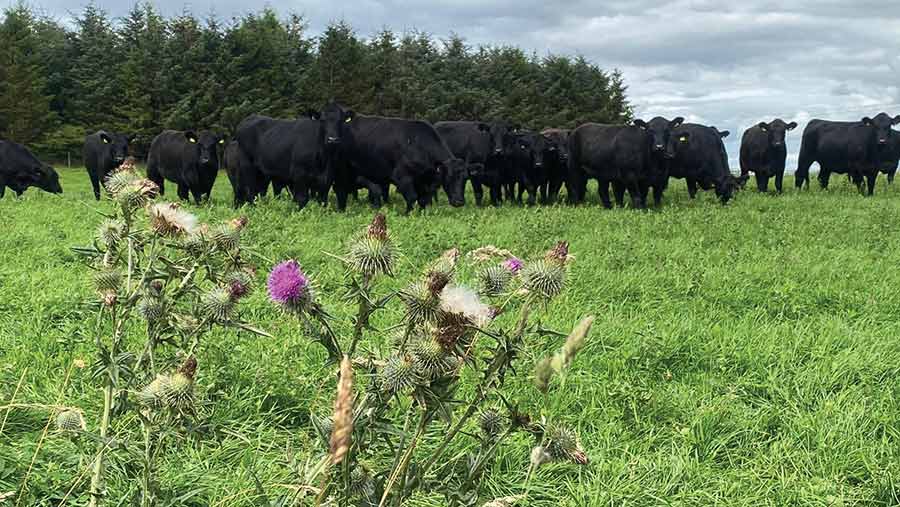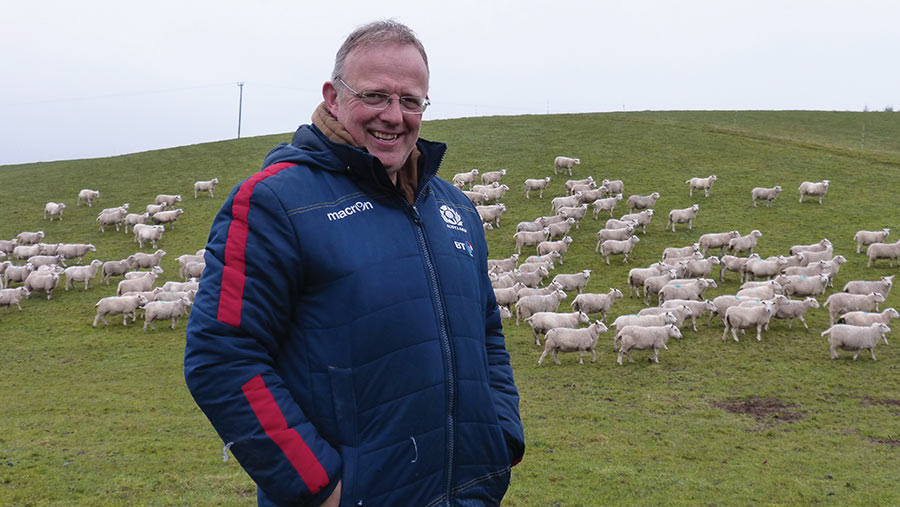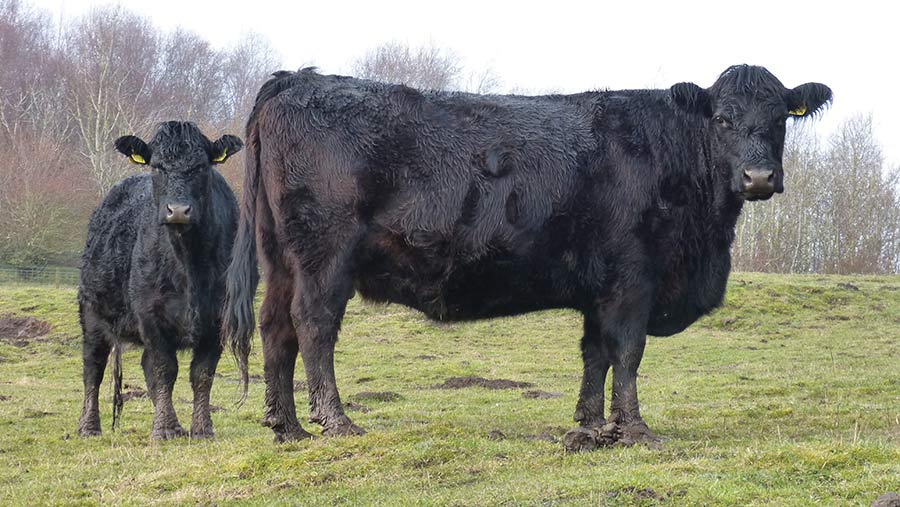Time saving aids upland suckler cow expansion
 © Michael Blanche
© Michael Blanche First-time farmer Michael Blanche has used business management tips to increase off-farm income to fund the expansion of a suckler herd.
The offer of an annual grazing let of 210ha (519 acres) of good-quality, in-bye grassland by a local landowner made this expansion possible.
The herd of Angus-cross cows, which is farmed in partnership with a neighbour, should provide a retirement pot for Michael, who farms at Culteuchar Farm, Forgandenny, near Perth.
Now 54, he is betting on having 11 years of farming remaining. He expects to bull 85 females this summer and eventually share 180-head with his neighbour.
See also: How visiting other farms can improve business resilience

Michael Blanche © MAG/Michael Priestley
Time saving
By organising his time and fine-tuning his livestock systems, Michael has saved more than 10 hours a week on his winter routine, which is now 24 hours a week on his 150 livestock units at home.
He estimates that before, the same jobs took 40 hours or more. Time saved can be spent off-farm doing consultancy and advisory work. He also balances being a husband and father, and running a podcast, called the Pasture Pod.
His aspirations for limited hour weeks were:
- Aim for a maximum of three hours of farming on a typical day
- One day a fortnight can be full time
- Occasional infrastructure projects are a “free pass” and do not count
- Four weeks of lambing and calving can be full time.
While Michael acknowledges his interest in being efficient is a bit “left of field”, he explains it has given him more time to work off-farm and build the cash to grow his suckler herd (see “Herd-building partnership”).
“I’m still quite messy and disorganised, but I’ve seen how powerful small daily changes can be,” he explains. “I’m definitely getting better and more structured. I can feel progress happening.” (See “Time-saving tactics”).
Farm facts: Culteuchar Farm and expansion
- 590 ewes and 220 hoggs
- 50% share in 62 Angus-cross sucklers
- Additional flock contract-farmed for neighbour
- Managing 390ha, of which 200ha is shared 50:50 with a neighbour.
Industry impact
Farmers Weekly had positive feedback to an article (April 2023) about Michael’s efficiency drive. However, some readers questioned whether being a livestock farmer meant accepting that the job was unavoidably tiring and time-consuming.
Elsewhere, Michael’s story has gathered momentum:
- Podcast Farmers and time-management gurus interviewed in a six-part podcast series Michael released in January 2023 called, “It’s About Time”. Sponsored by the Frank Parkinson Agricultural Trust, it averaged close to 4,000 downloads an episode.
- Webinars Two webinars covering time-management tips, and challenges.
- Farmer meetings AHDB signed Michael up to do three knowledge exchange days in February, at which he gave tips on prioritising tasks.

© MAG/Michael Priestley
Herd-building partnership
Before the extra ground became available, Michael and his neighbour were already two years into a co-operative herd-building scheme, growing capital in cows.
The partnership will calve 62 this summer, 18 of which are home-bred. Michael attributes the following elements of their relationship to the success of the joint venture:
- Simplicity Ownership of every animal is split 50:50, so there is no complication with ear tag numbers or when animals are culled
- Trust Michael has developed a good working relationship with his neighour, having been employed by them to contract-shepherd for the past seven years
- Communication Any joint venture is based on open and transparent communication about each objective. Every six months, they check if the agreement is still on track
- Strategic alignment Michael and his partner are a similar age and share goals to build the herd and sell it before retirement. Another party has expressed interest in buying into the herd, which would help the partnership’s cashflow
- Paperwork An official share-farming contract has been written and signed, which details responsibilities. An annual inventory tracks the herd, recording progress and profit share
- Co-operation Because profits are shared, both parties are incentivised to make it work.
- Camaraderie Working together allows the opportunity to have a laugh, which they both think is important
- Labour sharing Michael’s partner does half the workload on the cows when he is getting off-farm income, the cows are still checked, and bales opened in winter. Michael believes two half-labour units may be better than a full one.
Michael Blanche’s time-saving tactics
Genetics
- Low-input stock To breed more robust animals, those needing assistance at lambing or prone to dagginess or lameness are given a yellow slaughter tag; ram lambs selected from the best sheep (given green tags) are kept to tup the flock. As a result, lameness has fallen from 20% to 3%; lambing assistance stands at 5.4%; and mortality from lambing to marking is at 14%. No feet are trimmed, and no sheep or lambs are dagged. Wiltshire Horn – a shedding breed – is in the flock’s genetic background, and Michael has bred for shorter tails.
- Moderate size Because sheep weigh 55kg on average (aiming for 65kg average for prolificacy and carcass), they overwinter with minimal inputs as they meet their maintenance requirements. Half the flock graze right through the winter without supplementation. Michael bought just 2t of concentrate feed last year, for rearing ewe hoggs.
- Forage-based Home-bred ewes are selected in a three-day rotational grazing system and rams and bulls are bought from breeders that do not use concentrate feed to grow sires. This means stock fit the system.
Mobs
- Sheep Number of mobs has been cut from six to three (singles, multiples and ewe lambs) in summer, and just two in winter (ewes, and ewe lambs, kept on a neighbour’s farm).
- Cows Three mobs are run: heifer calves, first calvers and mature cows.
- Health Last year, 320 ewes affected with jaagsiekte sheep retrovirus and contagious ovine digital dermatitis were culled. They had been run separately, which took a lot of time.
Contract shepherding
- Michael has reduced the time needed to fulfil his contract-shepherding commitment by getting more help for manual tasks and focusing on compliance, paperwork, and farm assurance jobs.
Gate alterations
- Michael timed moving sheep across a road, through a steading and past a garden to the next field – it took 46 minutes and three people, with the actual moving only taking four minutes of that. He has since fenced off a track and put in new gates to avoid the steading at a cost of £1,100. This should save time and need only two people to move the sheep.
Future plans
- Increase deferred grazing Grazing is the most time-efficient way to feed stock. Silage feeding will be minimised as much as possible, mainly for resting lambing paddocks for spring rotations.
- Winter feeding blocks Michael aims to produce silage adjacent to wintering ground to minimise travel in winter.
- Shed revamp Rubbish from the yard and two sheds have been cleared into a skip. Shadow boards for tools, and “hotspot” areas for related equipment (tagging stuff, water connectors and so on) will be used to keep sheds tidy.
